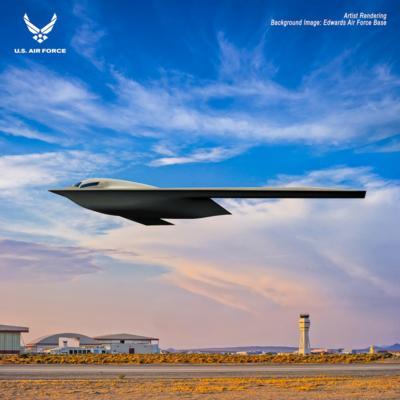Planned Rollout to Disclose Little
In the 1940s, Jack Northrop—the aeronautical titan whose genius engendered aircraft the likes of Charles Lindbergh’s Spirit of St. Louis and the P-61 Black Widow—drummed up a great deal of excitement with his YB-49 Flying Wing.

Northrop’s boldly revolutionary design eliminated the traditional empennage, thereby producing a giant, boomerang-shaped contraption in which public fascination was vigorously stoked by regular appearances in newsreels and popular magazines of the day. Alas, the YB9 manifested flight-control problems beyond the purview of pre-digital technology—problems that compelled the U.S. Air Force to cancel the project in 1949 and continue its search for an inheritor to the B-29 Superfortress’s title as America’s premier long-range tactical bomber.
To this day, controversy surrounds the YB-49’s cancellation. But cancelled it was, and flying wing technology lay dormant until the late 1970’s, when the Pentagon—disregarding the Carter administration’s pusillanimity—launched its Advanced Technology Bomber (ATB) initiative, from which arose the lauded and iconic B-2 Spirit—aka Stealth—strategic, heavy bomber.
For all the Spirit’s vaunted technology and the facility with which it and Lockheed’s F-117 Nighthawk fighter contemporaneously ushered in the ongoing era of stealthy flying machines, the B-2 is not a new airplane. Improbable though it may seem, the type first flew in 1997—33-years ago—and has grown long in the proverbial tooth. Cognizant of such, the Air Force, in 2015, awarded Northrop Grumman a contract to develop a new Long-Range Strike Bomber (SRB) to replace not only the B-2, but Rockwell’s speedy B-1 Lancer, and Boeing’s uncannily timeless B-52 Stratofortress.
At the 2016 Air Warfare Symposium, the airplane Northrop Grumman dreamed up was formally designated B-21, signifying it as the 21st Century’s first clean-sheet bomber. The aircraft is a fifth-generation, flying-wing, global precision attack platform that Northrop Grumman asserts will give the United States networked sensor-shoot capability—a military doctrine that posits to translate an information advantage, enabled largely by information technology, into a competitive advantage via the clever computer networking of well-informed, geographically dispersed forces.
It was also announced in 2016 that the American people would be made aware of neither the cost of the new bomber for which they were paying nor the number of subject bombers the Pentagon intended to commission. The Pentagon couched its artifice in claims that making public the B-21’s costs would reveal too much about the classified project to U.S. adversaries. The service did, however, deign to disclose that the B-21 would be ascribed the formal nom de guerre Raider in honor of the Second World War’s famed Doolittle Raiders.
In a September 2022 press conference at the Air Force Association’s Air, Space, and Cyber event in National Harbor, Maryland, USAF acquisition executive Andrew Hunter set forth that the B-21 Raider was to roll out of Northrop Grumman’s Palmdale, California plant in early December.
Asked whether the entire aircraft is to be revealed at the roll-out, USAF Major General Jason R. Armagost—in keeping with the reticence in which the Pentagon has veiled its new bomber—replied: “You probably won’t see it from all aspects.”
Northrop Grumman corporate vice president Tom Jones stated: “Northrop Grumman is proud of our partnership with the U.S. Air Force as we deliver the B-21 Raider, a sixth-generation aircraft optimized for operations in highly contested environments.”

Considerably less bluster was allocated to the fact that the vessel to be rolled out this December is indeed neither a specimen of the B-21 nor even a prototype of such. Rather, the object Northrop Grumman is making ready to premier is being quietly called a production representative of an architecture Melissa A. Johnson of the USAF’s Rapid Capabilities Office claims is conducive to reconfiguration in the face of changing threats.
Whether or not Ms. Johnson’s answer constitutes an evasion or an admission that the B-21 remains an inchoate concept and not an extant aircraft remains to be seen—albeit not, apparently, by the citizenry whose overburdened pocketbooks are apt to be remembered as the appositely named Raider’s first targets.
 Klyde Morris (10.27.25)
Klyde Morris (10.27.25) Airborne 10.27.25: MOSAIC Phase 1, Katana Returns, MOSAIC Town Hall!
Airborne 10.27.25: MOSAIC Phase 1, Katana Returns, MOSAIC Town Hall! Airborne-NextGen 10.28.25: Police Drones, Nat'l Parks v UAVs, MOSAIC Phase 1
Airborne-NextGen 10.28.25: Police Drones, Nat'l Parks v UAVs, MOSAIC Phase 1 ANN FAQ: Follow Us On Instagram!
ANN FAQ: Follow Us On Instagram! NTSB Final Report: Airbus A321-271N (A1); Cessna 172N (A2)
NTSB Final Report: Airbus A321-271N (A1); Cessna 172N (A2)



